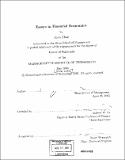| dc.contributor.advisor | Andrew W. Lo. | en_US |
| dc.contributor.author | Chae, Joon, 1967- | en_US |
| dc.contributor.other | Sloan School of Management. | en_US |
| dc.date.accessioned | 2006-03-24T16:22:44Z | |
| dc.date.available | 2006-03-24T16:22:44Z | |
| dc.date.copyright | 2003 | en_US |
| dc.date.issued | 2003 | en_US |
| dc.identifier.uri | http://hdl.handle.net/1721.1/29757 | |
| dc.description | Thesis (Ph. D.)--Massachusetts Institute of Technology, Sloan School of Management, 2003. | en_US |
| dc.description | Includes bibliographical references (leaves 66-68). | en_US |
| dc.description.abstract | In Chapter 1, I investigate trading volume before scheduled and unscheduled corporate announcements to explore how traders respond to private information. I show that cumulative trading volume decreases by more than 15% prior to scheduled announcements. The decline in trading volume is largest when information asymmetry is high, while the opposite relation holds for volume after the announcement. In contrast, trading volume before unscheduled announcements increases dramatically and shows little relation to proxies for information asymmetry. All the results for scheduled announcements are consistent with asymmetric information theories, where discretionary liquidity traders (DLTs) decrease volume when they know there is much adverse selection. However, DLTs do not seem to read information embedded in prices before unscheduled announcements. I further investigate the behavior of market makers and find that they act appropriately by increasing price sensitivity before all announcements. This implies that market makers extract timing information from their order books. Chapter 2 is joint work with Li He and professor Andrew W. Lo. We implement various statistical analyses on stock market returns, using CRSP equal weighted and value weighted index returns from 1926-2001, as Fama (1965) did more than 35 years ago. Investigating marginal and conditional stock return distribution, we report many characteristics of stock return distributions. First, stock return distribution is still not following a normal distribution even though many studies have been assuming this. | en_US |
| dc.description.abstract | (cont.) Second, autocorrelations of stock market returns are not zero as verified by many predictability studies. The magnitude of autocorrelations varies considerably from one period to another. In addition, we analyze several stock market anomalies, such as January effect, turn-of-the-month effect, turn-of-the-quarter effect, and weekday effect. Interestingly, most effects are still significant after many years of their discoveries. | en_US |
| dc.description.statementofresponsibility | by Joon Chae. | en_US |
| dc.format.extent | 99 leaves | en_US |
| dc.format.extent | 3540143 bytes | |
| dc.format.extent | 3539952 bytes | |
| dc.format.mimetype | application/pdf | |
| dc.format.mimetype | application/pdf | |
| dc.language.iso | eng | en_US |
| dc.publisher | Massachusetts Institute of Technology | en_US |
| dc.rights | M.I.T. theses are protected by copyright. They may be viewed from this source for any purpose, but reproduction or distribution in any format is prohibited without written permission. See provided URL for inquiries about permission. | en_US |
| dc.rights.uri | http://dspace.mit.edu/handle/1721.1/7582 | |
| dc.subject | Sloan School of Management. | en_US |
| dc.title | Essays in financial economics | en_US |
| dc.type | Thesis | en_US |
| dc.description.degree | Ph.D. | en_US |
| dc.contributor.department | Sloan School of Management | |
| dc.identifier.oclc | 54664023 | en_US |
